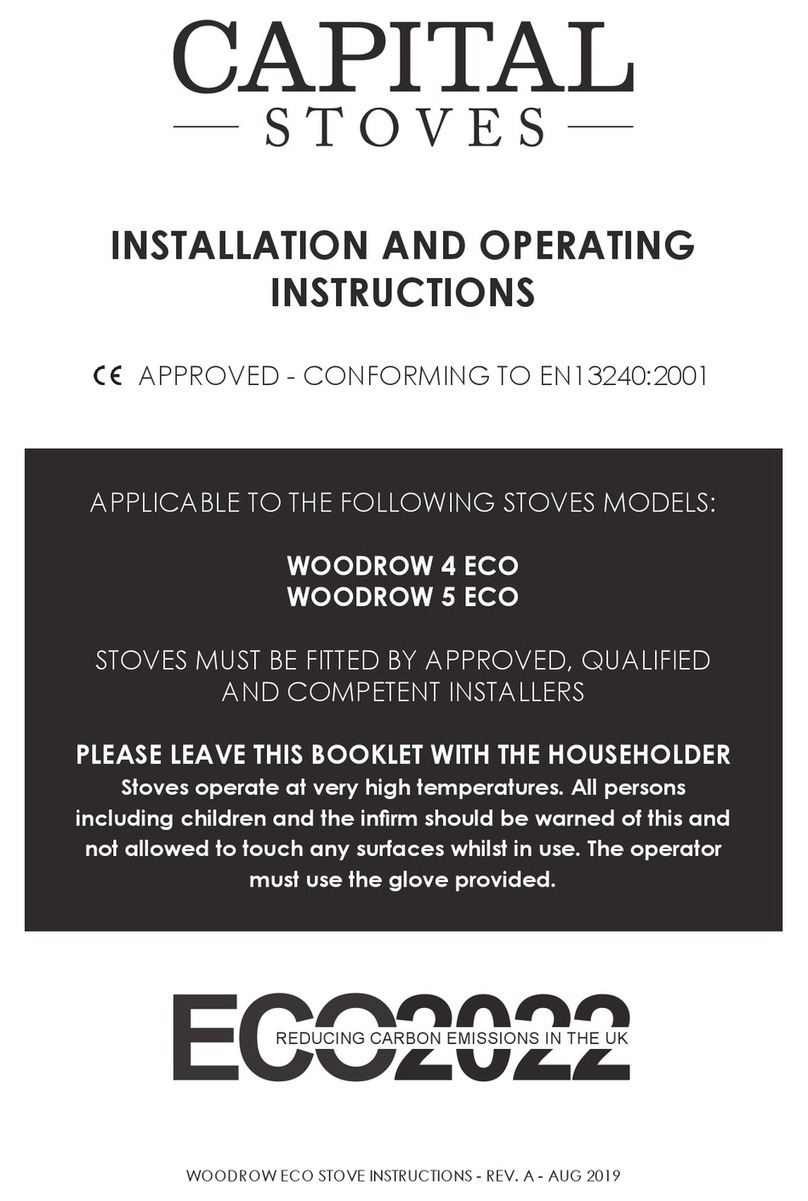When refuelling with wood or anthracite, the primary air control should be fully opened
for approximately 1 minute or until ignition is well established, then close to the desired
setting.
Refuelling onto a low fire bed
If there is insufficient burning material in the firebed to light a new fuel charge,
excessive smoke emission can occur. Refuelling must be carried out onto a sufficient
quantity of glowing embers and ash that the new fuel charge will ignite in a
reasonable period. If there are too few embers in the fire bed, add suitable kindling to
prevent excessive smoke emissions. Once the fire is established again, begin to refuel
with your chosen fuel and set the air controls as noted above.
Fuel overloading
The maximum amount of fuel specified in this manual should not be exceeded,
overloading can cause excess smoke.
Operation with door left open
Operation with the door open can cause excess smoke. The appliance must not be
operated with the appliance door left open except as directed in the instructions
Dampers left open
Operation with the air controls or appliance dampers open can cause excess
smoke. The appliance must not be operated with air controls, appliance dampers or
door left open except as directed in the instructions.
De-ashing
De-ashing is only required when excessive amounts of ash have built up.
The grate has two positions, open or closed. The open position is for de-ashing only. To
de-ash open grate with control knob, scrape ash through grate opening with tool
provided.
IMPORTANT - MAKE SURE ANY ASH BLOCKING THE FLUE THROAT (BOTTOM REAR OF THE
FLUE BOX) IS REMOVED.
Recommended Fuels
Seasoned wood - moisture content less than 20%.
Solid Fuel – Anthracite large nuts, briquette smokeless fuel i.e. Ancit, Phurnacite,
Taybrite, Homefire Ovals suitable for closed appliances. All coals must be listed as
exempt for use in clean burn areas.
Please note that when refuelling with solid fuel do not pile fuel higher than 30 degrees
from the front bar rearwards – overfuelling can produce temperatures beyond the
designed rating of the appliance causing damage of internal parts.
We recommend the majority of approved manufactured smokeless fuels. Household
coal (bituminous coal), which is “Smokey” fuel, can be burned in areas that are NOT
smoke controlled but the clean burn function will not be applicable. The use of
household coal is not recommended. Use as an incinerator is not recommended as
fumes from plastics etc will cause pollution to the atmosphere and will damage stoves
internals Should any difficulties arise over fuel quality or suitability consult your local
supplier or the solid fuel advisory service.
PETROLEUM COKE FUELS OR HOUSEHOLD WASTE SHOULD NOT BE BURNT IN THIS APPLIANCE
Should any difficulties arise over fuel quality or suitability consult your local supplier or the
solid fuel advisory service
8
Safety Notes For Your Guidance
FIRES CAN BE DANGEROUS – Always use a fire guard to BS8423:2002 specification in
the presence of children, the elderly or infirm. Inform all persons of the dangers of
high temperatures including the stove pipe and the use of operating tools provided.
DO NOT OVER FIRE – It is possible to fire the stove beyond its design capacity, this
could damage the stove, so watch for signs of overfiring – if any part of the stove
starts to glow red, the fire is in a overfire situation and the controls should be adjusted
accordingly. Never leave the stove unattended for long period without adjusting the
controls to a safe setting – careful air supply control should be exercised at all times.
Warning – Fume Emissions
Properly installed and operated, this appliance will not emit fumes. Occasional fumes from
de-ashing and refuelling may occur. Persistent fume emission must not be tolerated.
If fume emission does persist, then the following immediate action should be taken –
1. Open doors and windows to ventilate the room.
2. Let the fire go out, or eject and safely dispose of fuel from the appliance.
3. Check for flue chimney blockage and clean if required
Do not attempt to relight the fire until the cause has been identified. If
necessary, seek professional advice.
It is essential that the fire has adequate air supply for combustion and ventilation.
Apertures provided for this purpose shall not be restricted or blocked
Never use an aerosol spray near the appliance under fire
Do not fit an extractor fan in the same room as this stove as this may cause the
stove to emit fumes into the room
Your installer should have fitted a CO alarm in the same room as the appliance.
If the alarm sounds unexpectedly, follow the instructions given under “Warning
Note” above
General Maintenance
Basic maintenance can be carried out by the appliance operator, i.e. removal of
baffle plate, bricks, grate, and glass replacement, must be done when the appliance
is cold. Any structural repairs, i.e. panel or stove pipe replacement must be carried
out by a suitably qualified engineer.
Cleaning
It will be necessary to clean fly-ash off baffle plate in the top of the stove at least
once a month. When in regular use and after long shut down periods. To gain access
to baffle lift top brick and slide it side and backwards, remove right hand side brick.
Now top brick can be manipulated out of the stove door. You can now gain access
to the baffle plate. This can be removed, cleaned off and replaced. The top brick is
manipulated back into position and side brick replaced. Make sure top brick has
located all round.
Stove Body
The stove is finished with a heat-resistant paint and this can be cleaned with a soft
brush. Do not clean whilst the stove is hot; wait until it has cooled down. The finish
can be renovated with a suitable brand of paint.
9





























